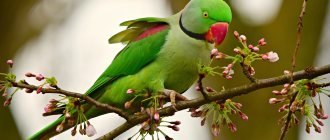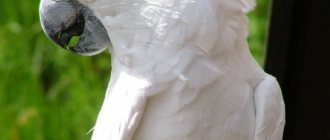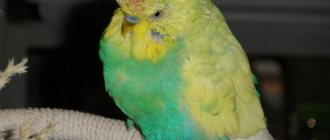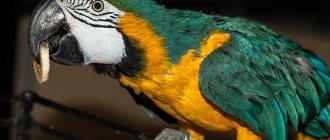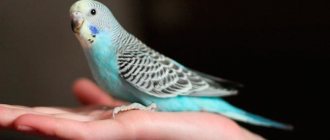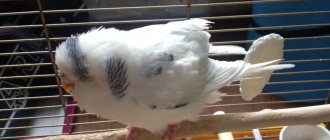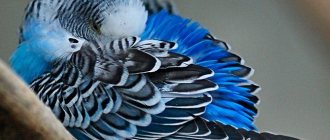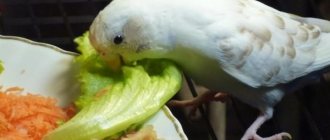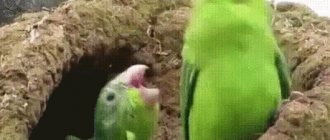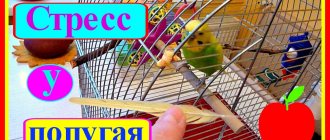- home
- Parrot
- FAQ
04/22/2019 People who have recently become owners of parrots may be surprised by many things in their habits. These birds are very curious and have their own behavior patterns and qualities. For example, one of their distinctive features is that they make a special sound through their beak, which is similar to a squeak. What could this mean? Why the cockatiel creaks its beak is of interest to novice owners.
Why do parrots click their beaks?
Beak clicking can be heard from birds at different times of the day and for different reasons. Most often, owners note unusual behavior after eating, as well as during sleep. All the reasons for this phenomenon can be divided into three categories:
- expression of emotions;
- nutrition and hygiene;
- diseases.
An attentive owner, when examining a parrot, can easily determine what caused this behavior in a particular case.
Emotions and mood
One of the reasons why parrots creak their beaks is to express emotions. Owners often notice that the parrot clicks its beak after walking, playing and interacting with people. This means that the bird is completely happy and feels as comfortable as possible.
However, a parrot can click its beak in the opposite situation - when it is experiencing severe fear or stress. The grinding sound can be heard when moving or changing ownership, but the bird will not make contact, and when attempting to interact, it will begin to drive the person away or try to bite him.
You can understand what causes the creaking by observing the behavior of the bird. Based on the appearance and actions of such emotional species as the budgerigar and cockatiel, it is easy to conclude what mood they are in.
Nutrition and hygiene
On the inner surface of the beak of parrots there are special teeth that help birds crack hard seeds, grains and nuts. Husks can get stuck between them, so after eating food, birds begin to creak their beaks, thus clearing them of contaminants. This behavior is especially typical for representatives of large species - cockatoos and macaws.
Parrots spend a lot of time caring for their plumage and skin. After hygiene procedures, they also tap their beak to clean it. In addition, by moving the beak and underbeak, birds sharpen their edges. They can do this even in their sleep. In this case, owners will hear a creaking sound.
Got sick
If, in addition to the clicking of its beak, your pet shows other signs of illness, this means that it is sick. The owner should be wary if the parrot has become lethargic, does not fly, does not sing, does not want to play and communicate, sits on a perch for a long time, ruffled, does not take food or water, and does not take care of itself. Diseases in which beak clicks are observed include colds, scabies and tracheal mites.
When a parrot has a cold, it breathes heavily, sits ruffled, sneezes, often swallows, and regurgitates food. When infected with scabies mites (knemidocoptosis), the bird develops growths on its paws and beak. Trying to get rid of them, the parrot creaks its beak. Tracheal mites penetrate the lungs and respiratory tract of the bird. The parrot begins to cough, sneeze, wheeze, breathes with its beak open, and makes clicking sounds. Without treatment, death occurs.
Feeling great
When a parrot makes a squeaking sound, you can interpret it as a message: “I am happy with my life in this house. I like it here, I have a good owner.” Now, if you do something wrong, for example, feed it poorly or do not take care of the cage enough, then such signals do not arise. In this case, it is better for you to seek advice from a professional ornithologist or stop tormenting the bird altogether and give it to good hands. A parrot is an extremely sensitive creature. If he doesn’t like something, it quickly affects his behavior, leading to depression, decreased activity, and illness. Depression that lasts too long inevitably leads to death.
While sleeping, your feathered friend may also reflexively click and squeak. This is a natural mechanism built into parrots by evolution. This is how they sharpen their beak, which is for them the main tool of labor given by nature. This action does not prevent them from sleeping. And yet, in order for your pet to spend less energy on sharpening, you should definitely place a cuttlefish shell and a piece of chalk (not school chalk) in the cage.
Other oddities in the behavior of parrots
There are several more incomprehensible actions that these birds often perform:
- Sleeping on one leg. Birds can sleep by alternately tucking one leg under them, then the other. Sometimes the second paw is not tucked in, but is placed on the bars of the cage. This is quite normal, but in some cases it may mean that your pet is cold. The main thing is that he does not lie on his side - this is unnatural for parrots.
- Low activity. If a parrot first flew a lot, and then suddenly began to behave too quietly, then it is most likely in a state of stress. Your guests could have upset the bird’s emotional balance if they interacted too hard with it. The stress could also be caused by a cat trying to get the bird through the bars when you were not around. In addition, this fragile creature could be very frightened by the loud sound made by a hairdryer, vacuum cleaner or other electrical appliance.
Oddities in the behavior of parrots are not uncommon. The creaking of the beak is probably the most harmless of them. And, as you should already understand, it usually does not indicate anything bad.
How to encourage a parrot to click its beak
To hear clicks from your pet more often, you need to create comfortable conditions for him. The cage should be spacious and clean. Inside it should be placed perches made of natural materials, as well as various toys: swings, ladders, ropes, etc. You can provide your pet with a bath of sand or water for bathing.
You need to feed your parrot a variety of foods. The diet should contain grains, nuts, seeds, fresh fruits, vegetables and herbs, animal products, vitamin and mineral supplements.
To satisfy your parrot's need for communication, you need to engage with it as often as possible. It is important to talk and play with the bird, as well as take it for a walk every day. Interaction with humans is especially necessary for individuals that are kept alone.
When does this happen
People who breed these animals often hear a clicking or creaking sound that the birds make. It is easy to determine that they produce it with a specific movement of the beak.
Most often, parrots will fasten their beaks after eating. They can also grind in their sleep in order to sharpen their beak, since this is how they get their food. During the procedure, they sleep fully.
Treatment methods
With the variety of diseases faced by cockatiels, budgies and others, there are also many treatment options available. If you want to help your pet yourself, then refer to the following methods.
- When you have a cold, you need to increase the temperature inside the animal's cage. This can be done by covering it with a towel or placing a warm lamp near it.
- If the bird is poisoned, an activated carbon solution will help. Give using a syringe without a needle; this must be done carefully so that the parrot does not choke. Usually from 4 to 6 drops 3 times throughout the day.
- If you are dehydrated, you can add glucose to food and water; it will help the liver function, which prevents intoxication of the body.
- If a bird pulls out its feathers, then you should ventilate the room more often, place the cage in a more sunny place, but avoid cooling and overheating.
- When there is no chalk or mineral stone sharpener in the cage, the pet may grow too long a beak and claws. This causes him great discomfort.
- In case of poisoning, the symptoms of which may be diarrhea and vomiting, a solution of glucose or citrus juice also helps.
General impression
Corella parrots are friendly and trusting birds. However, without constant communication with the owner, the cockatiel can quickly turn into a wild parrot, responding with aggression to any human movement. After all, these are very proud birds that do not tolerate disdain for their person.
Cockatiels can become devoted companions who fall in love with their owner. But the parrot will reciprocate only if you give your pet daily attention, take care of it, play, and periodically let it out of the cage. And then you will be able to feel how they amusingly finger the hair on your head as a sign of their fidelity and boundless love.
Only by respecting the cockatiel and satisfying his personal needs can you buy an affectionate pet that will greet you with joyful cries every time. Of course, not all birds are the same; each has its own personality and preferences. But in general, these parrots are pleasant birds to talk to.
WHAT DISEASES ARE BUDGATES AND CORRELLAS SUBJECT TO?
Normally, parrots' stools are greenish or brown in color. Changes in the color and consistency of feces indicate pathological disorders occurring in the body of birds. Liquid, homogeneous stool indicates the development of diarrhea, which, depending on the causes of the disease, varies in color: white, green, black.
WHITE DIARRHEA
White, beige or grayish diarrhea occurs in parrots whose diet contains fatty foods. When white diarrhea appears, it is necessary to exclude seeds, nuts, and milk from the bird’s diet. White spots can be the result of arthritis, stress, infections, and liver damage.
The coloring of loose stools green most often indicates that the pet is poisoned. Green stools also occur when infected with parasites and worms. Sometimes green diarrhea occurs when eating large amounts of greens.
Loose, black stools are a sign of internal bleeding and parasitic infections. An indicator of bleeding may be the presence of blood in the stool or the coloring of the stool in a red tint.
WHY DOES WATER DIARRHEA OCCUR IN PARROTS: BUDGATES AND CORELLAS?
Cockatiels and budgies are most often susceptible to the following ailments:
- Goiter diseases. This type of pathology is associated primarily with poor nutrition, consumption of contaminated water and stale food, and infectious and viral diseases.
- Inflammatory eye diseases that occur either against the background of infections, various pathological disorders in the body of birds, or due to foreign particles entering the eye membrane.
- Digestive disorders, manifested primarily by loose stools or constipation.
- Infection of cockatiels and budgies with parasites, ticks, fleas.
- Joint diseases, which are primarily caused by vitamin and mineral deficiency.
- Feathered pets are susceptible to colds. In this case, the first sign will be redness of the eyelids, a change in the bird's voice, and sneezing. Most often, the cause of colds in cockatiels and budgies is drafts, therefore, after ventilating the room, it is better to move the bird to another room.
- Often, cockatiels and budgies experience increased feather loss. This may be due to seasonal molting, which occurs twice a year, while the falling plumage does not form bald spots, bald spots and wounds on the body of the birds. Another reason for feather loss may be the parrot's infestation with parasites and fleas. In this case, the pet will behave restlessly, pluck feathers, and itch. Also, loss of plumage can provoke vitamin deficiency.
- Beak diseases.
The following signs indicate parrot disease:
- hard breath;
- lethargy, immobility;
- suppuration and tearing of the eyes;
- poor appetite or lack thereof;
- uncoordinated movements;
- excessive feather loss;
- redness of the skin on the paws;
- the appearance of growths in the goiter area;
- noticeable weight loss;
- vomit;
- constipation;
- diarrhea.
If you find the listed signs in budgies and cockatiels, you should immediately call a veterinarian at home or visit a veterinary clinic with your feathered pet.
Loose stools or water diarrhea in parrots is the most common disease. And the development of this disease is primarily promoted by poor care of the pet and inappropriate living conditions. The following factors can cause diarrhea:
- Viral and infectious diseases, of which the most severe and dangerous is salmonellosis, which often causes severe diarrhea, rapid dehydration and death.
- An unbalanced diet, which leads to vitamin deficiency, and a lack of minerals and vitamins leads to disruption of the functions of many systems in the body, including the digestive one. The absence of millet in the diet or the predominance of grains causes indigestion and diarrhea in birds. Lack of calcium also negatively affects the digestive system.
- Stale food, dirty and stagnant water contain bacteria that poison and affect the digestive tract of birds, leading to diarrhea.
- Poisoning from poisonous plants in the house. Owners of parrots should take into account the fact that their feathered pet can peck and pinch house flowers and, in order to avoid unpleasant consequences, it is better to get rid of such plants.
- Chemical poisoning. This even includes an air freshener.
- The predominance of greens and fruits in food, which enhance the functioning of the gastrointestinal tract, which provokes the appearance of loose stools.
- Failure to comply with hygiene standards. The cage and utensils must always be kept clean to prevent the development of pathogenic microorganisms.
- Drafts and hypothermia are the cause of colds and weakened immunity, in which cockatiels and budgerigars experience diarrhea with water, as well as vomiting.
- Stressful situations, such as fear, loud noises, screams, mistreatment of the pet, change of environment and owners, other pets (cats, dogs).
- New food.
- Binge eating.
- Pathologies of the digestive organs, liver, kidneys.
- Goiter diseases.
- Tumor formations.
- Carrying out therapy with the use of antibacterial drugs that disrupt the intestinal microflora and provoke diarrhea with water.
WHAT IS WATERY STOOL DANGEROUS?
Normally, the stool of budgies and cockatiels is soft, formed, and has a green or brown tint, this depends on the diet of the birds. Changes in the consistency of feces indicate pathological disorders occurring in the body of birds. Thus, a thicker and even harder consistency of stool is a sign of constipation.
A thinner consistency of stool is a sign of diarrhea. But not all liquid discharge in parrots is diarrhea. The fact is that both feces and urine in birds are collected in the cloaca - an extension of the hind intestine, from where they are excreted simultaneously. Formed stools surrounded by a small amount of fluid are normal.
And if the feces are a homogeneous liquid mass, it can be said that the bird has diarrhea. Diarrhea is sometimes confused with polyuria. This is a kidney disease in birds in which excessive urine production occurs as a result of impaired absorption function. Signs of polyuria are liquid feces, released in large quantities, in which formed feces are found.
That is, loose stools in parrots occur as a result of diarrhea or polyuria. Diarrhea occurs due to disruption of the digestive tract for various reasons. Polyuria is a disorder of the kidneys. Therefore, increased wateriness is observed in stool.
Diarrhea that lasts more than a day poses a fatal threat to parrots. A pet can die primarily from dehydration, which leads to exhaustion, rapid loss of body weight, and loss of strength. In addition, lack of fluid contributes to blood thickening, which leads to poor circulation, oxygen deficiency and death.
This happens literally in a few days, so it is strongly recommended to monitor your feathered friend in order to begin treatment for the disease in a timely manner. In addition, with frequent bowel movements, the muscle tissue of the walls of the cloaca is greatly stretched, causing it to fall out. The prolapsed cloaca dries out over time, and this provokes the appearance of itching, discomfort, and pain in the anal area.
SYMPTOMS OF DIARRHEA IN PARROTS
Diarrhea causes a lot of trouble for your feathered pet. With frequent loose stools, the parrot quickly loses weight, which is not immediately noticeable due to its plumage. Weight loss, accompanied by weight loss, can be noticed when palpating the bird. When losing weight, growth is noticeably felt on the bird's chest. In its normal state, the keel bone protrudes only slightly. In addition to weight loss, there are many other symptoms of diarrhea, such as:
- the pet may refuse food;
- malaise and weakness appear;
- the parrot sleeps a lot of time or is in a motionless position for a long time, ruffled;
- the bird becomes lethargic and silent;
- apathy and indifference to what is happening around appears;
- there is inflammation around the cloaca;
- the plumage under the tail becomes sticky and dirty;
- stool acquires a liquid, homogeneous consistency; a change in the color of the stool or inclusions of green, red, white, or gray may be observed.
If not treated promptly, this condition can lead to irreversible consequences, including the death of the pet. Therefore, if the listed signs are detected, you should immediately seek advice from a specialist ornithologist, who will prescribe the appropriate treatment.
Nutrition for diarrhea plays a huge role in its treatment. Any foods rich in fats and fiber should be excluded. These are nuts, fruits, herbs and vegetables; you should also avoid grain mixtures for now. In the first days of illness, you can feed the bird only rice porridge or water it with rice water. Here is the entire diet for the period of treatment, to which you can add only infusions and decoctions of plants.
Cockatiels, like budgies, are not demanding in care, but to prevent the development of diseases, you need to follow preventive measures, which include the following:
- Check the expiration dates of the food.
- Keep the cage clean.
- Avoid drafts in the room where the parrot is.
- Water and food should always be fresh.
- Make the transition to a new food gradually.
- Avoid situations that could lead to stress for your pet.
- If necessary, clean the bird's plumage, do not forget about the anus.
- Provide your parrot with optimal thermal conditions. The room should not be cold or hot.
- The cage should be placed in a bright room, not in direct sunlight.
In addition, it is important to create a diet that will provide your pet with the necessary minerals and vitamins. To prevent the development of diarrhea, food should include grains: millet, oats, flax, wheat, hemp seeds. They can be given either raw or boiled. Fruits, vegetables, and herbs are used as a source of important elements.
But not in large quantities, the predominance of such food will cause diarrhea. You can give eggshells containing a large amount of calcium, because its deficiency can cause diarrhea. In addition to the main food, it is recommended to add tree branches to the diet. Usually birch, apple, cherry, and linden are used. Tree branches are given not only because of the beneficial substances they contain; they are useful for birds to chew on for their beaks.
Meet Corella
Character traits
Cockatiels can be compared to small children. They have a very curious character. If the bird is sitting in a cage, it will watch your every move. If you release it “free” into the room, then get ready for the fact that the pet will start poking its curious beak everywhere.
For example, you sat down to read a book, be sure that the cockatiel will definitely look into it. And he might even try to chew the paper. At such moments, bird harmfulness may appear. If the parrot doesn't like the smell of the book, he can easily leave his droppings on it.
In this way, the pet hints that he does not like some object. You will have to either indulge his taste and remove things that the bird does not like out of sight, or try to wean the parrot from such behavior. We will describe below how this can be done.
Cockatiels are talkative birds, especially males. Unfortunately, their speech is slurred and has some defects - whistling, lisp, burr. These parrots also know how to sing and can repeat many melodies. But even here their harmful nature can manifest itself. Not every song or melody you include will be to the taste of your pet.
Basic preferences
Corellas are very sociable birds. As they walk freely around the room, they will follow you on your heels. They will be happy to keep you company both at the table and in front of the TV.
Do not forget that these parrots love not only to fly around the room, but also to run on the floor and sit on upholstered furniture. Be careful not to step on or sit on your pet. And never give your pet food from your table.
Cockatiels love to play. Old children's toys that can be chewed or taken apart are enough for them. With such items the birds will be occupied for hours. The main thing is not to give your pet toys that have small parts. Otherwise he may choke. You can also make your pet a play corner with swings, ropes and ladders.
However, toys and playgrounds alone will not get rid of your pet. Cockatiels cannot be alone for a long time and constantly entertain themselves on their own. Even adding brothers to your parrot will not save you from daily communication with the bird. In this case, you will have to pay attention to all the parrots.
Remember that without your care your cockatiel will become stressed. In addition to the fact that he will turn into a wild aggressive bird, the pet will begin to become depressed and gradually waste away. If you don't correct the situation, your bird will die.
Some disadvantages
A pet like a Corella parrot is not suitable for everyone. Therefore, before purchasing this bird, be sure to read everything below.
Cockatiels have a knack for making a mess. They constantly throw food away. It’s good if you have trained your bird to eat in a cage. But even in this case, she will throw food out of it over a relatively long distance. When you enter the room where your parrot lives, you will often step on leftover food: from husks to carrot pieces. What can we say about those moments when a pet eats outside the walls of its own cage.
A lot of garbage remains from cockatiels. They love to clean their own feathers, tearing out the extra ones, and defecate wherever they see fit. Feathers and droppings are not the only things you will periodically find both at the bottom of the cage and throughout the floor. Especially after bird walks around the room.
Corella parrots produce a large amount of dust, which you will also find wherever these birds have visited. If you do not remove dust at least every other day, it will begin to accumulate and will be scattered throughout the room with any movements of the parrot. This is not a problem for parrots, but for you?
Other strange habits of parrots
Many actions in a pet's behavior can surprise new breeders. The most common oddities are:
If the owner has heard creaking sounds from a bird's house and noticed that the bird is sitting with its feathers fluffed up and its beak creaking happily, there is no need to give in to excitement. This is what a pet happy with life looks like. This means that the parrot loves its owner with all its heart. You just need to try to answer him at the same price. Then one day you too will be able to hear this curious sound, thanks to which any breeder will experience incomparable happiness.
Source
